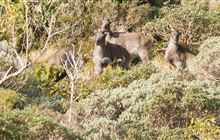Action on Himalayan tahr vital to conservation
Archived content: This media release was accurate on the date of publication.
Introduction
DOC’s Himalayan tahr control work, vital to protecting the unique alpine landscapes of the South Island, resumes this week.Date: 05 March 2019
DOC’s Director Community Engagement, Dr Ben Reddiex, says DOC will continue working with the hunting community to reduce tahr on conservation land.
“There are reports of numerous tahr herds foraging through tall tussock and other native alpine plants.
“Latest population estimates put the tahr population, across approximately 1.7 million ha of land, at nearly 35,000 animals, well above the limit of 10,000 tahr set out in control plans years ago.
“Urgent action is needed. It is important we stop the population migrating further than the current feral range.
“DOC’s Tahr Control Operational Plan sets to remove 10,000 tahr by the end of August 2019 and we are committed to working with the recreational and commercial hunting sector to achieve this.
“Initial control efforts will focus on tahr exclusion zones and in associated buffer areas."
Opportunities for the hunting community include:
- DOC will leave bulls in the seven Tahr Management Units for recreational and commercial hunters to hunt
- organised recreational hunting groups, Wild Animal Recovery Operations (WARO) and Aerially Assisted Trophy Hunting off-sets will be counted
- information on the location of any bulls will be provided to the hunting sector.
Approximately $1 million has been allocated for Himalyan tahr control and further research into tahr abundance and its impacts on the environment until August this year.
“There is no plan to eradicate tahr however we need to ensure that New Zealand alpine ecosystems are protected from the growing tahr population,” says Dr Reddiex.
Additional information
The Tahr Control Operational Plan identifies locations where DOC and the hunting sector should focus on controlling tahr.
DOC’s control work will initially prioritise the northern and southern ‘exclusion zones’ and adjacent feeder valleys.
DOC will pause its aerial control operations in the seven management units between May to June 2019 and resume control work until 31 August 2019. This allows for the tahr rut season and the fact that aerial tahr control is more efficient during winter.
DOC will target female and juvenile tahr and it is expected the hunting sector will increase its efforts to target all tahr.
Aerially Assisted Trophy Hunting offsets (where commercial trophy hunting businesses shoot an additional number of female and juvenile tahr based on how many male tahr their clients remove) will contribute to the count for control purposes.
Wild Animal Recovery Operation concession holders may also contribute to tahr control by removing tahr.
The Tahr Liaison Group includes representatives from Te Runanga o Ngāi Tahu; and the following stakeholders:
- Canterbury Aoraki Conservation Board – on behalf of the Canterbury, West Coast and Otago Conservation Boards
- New Zealand Deerstalkers’ Association
- Safari Club International (New Zealand chapter)
- New Zealand Professional Hunting Guides’ Association
- Wild Animal Recovery Operators
- Royal Forest & Bird Protection Society
- Federated Mountain Clubs
- Federated Farmers - High Country Committee
- Aerial Assisted Trophy Hunters
- Tahr farmers
- Game Animal Council
- New Zealand Tahr Foundation
- New Zealand Game Estates
Contact
For media enquiries contact:
Email: media@doc.govt.nz


